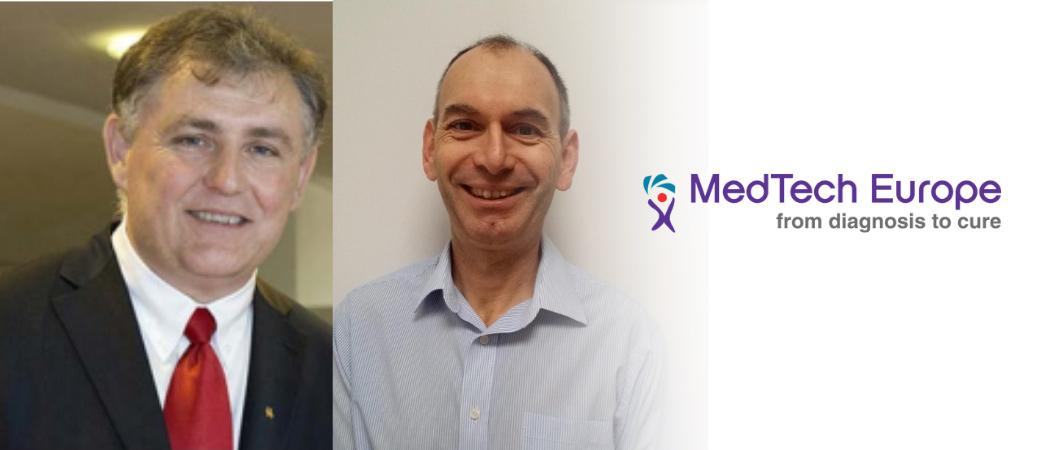Experts from MedTech Europe call for action to combat antimicrobial resistance and hospital-acquired infections

Dr Goran Ribaric (left), Dr Claude Mabilat (right)
In the heat of the battle against COVID-19, hospital doctors made extensive use of antibiotics. Now that the disease is better understood, experts say that things should be done differently.
“The habit of the prudent use of antibiotics was completely disrupted, if not forgotten, during the initial phase of the pandemic,” says Dr Claude Mabilat of medical diagnostics company bioMérieux. “Now that we are getting back to normal, it needs to be re-emphasised, because we are in a never-ending fight against antimicrobial resistance. It’s a slow pandemic.”
“The more antibiotics you use, the more potential there is for creating antimicrobial resistance,” adds Dr Goran Ribaric from Johnson & Johnson Medical. “This is why we have this slogan about antibiotics: the more you use them, the more you lose them.”
Together Mabilat and Ribaric chair the working group on antimicrobial resistance (AMR) and hospital-acquired infections (HAIs) at MedTech Europe, the European trade association for the medical technology industry (medical devices, In vitro diagnostics and digital health). They are closely involved in efforts to ensure sensible of use antibiotics (which are used to fight bacterial infections) – an approach more formally called antimicrobial stewardship – and are keenly aware of the dangers if discipline is not restored.
Fighting the wrong battle
Retrospective analyses have shown that very few patients admitted to hospital with COVID-19 had bacterial infections. One UK study, published in The Lancet Microbe in June, found that the small number of bacterial infections that were detected had been contracted after the patients arrived in the hospital.
The first challenge in a return to good antimicrobial stewardship is rapid diagnosis, so that doctors know what they are dealing with. “That’s the added value of diagnostics: as soon as we know what an infection is, we can avoid using antibiotics, because antibiotics are only effective against bacteria and not viruses,” says Mabilat.
Where there are bacterial infections, diagnosis should also help identify the most effective antibiotics to use. Rather than broad-spectrum antibiotics, which carry a heightened risk of causing resistance, more specific antibiotics can then be used to control what are effectively hospital-acquired infections.
But this needs to be part of a broader push to stop the spread of all infections in hospitals. “We know that hospital infections are preventable if people comply with safety protocols, and especially if we enlarge those protocols to include airborne transmission routes,” says Ribaric. “This airborne route is very much in our sights because of COVID-19, but it will also help control tuberculosis, measles and other infections that can be a problem in hospitals.”
He and his colleagues want to encourage a three-part strategy for infection prevention. First of all, there are antimicrobials, including antibiotics, but also practices, such as the use of sutures with antimicrobial coatings to prevent infections when patients are particularly vulnerable. Then there are epidemiological measures, such as testing and diagnosis, hand hygiene and mask-wearing. Finally, there is a need for behavioural change, so that people follow safety protocols.
“We could do better on all three,” says Ribaric. He singles out safety checklists as a good place to begin. “A lot of the safety improvements in commercial aviation came from using checklists, and doing that digitally for infection control in hospitals, so that the information travels further and faster, could be very useful.”
Taking a more systematic approach at European and national level
A more proactive approach will also be crucial. “We need to have surveillance for pandemics like COVID-19, because sooner or later new viruses will arrive, but the same is true of AMR,” explains Mabilat. “We need to be more active and proactive with the surveillance of AMR, which travels in the same way as a viral infection. We have to be aware when there is a rise in resistance in a particular region.”
It is also important to take advantage of the increasing digitalisation of healthcare systems, so that data is shared rather than trapped in particular silos. “It could be patient data, microbiological data about infections, and the therapies being used,” he goes on. “Integrating that data benefits prevention, treatment, and the cost-effectiveness of healthcare. When you have all the data together, you can see the connections and respond more effectively.”
The European Commission is well aware of the long-term challenge posed by antimicrobial resistance. In September, Health Commissioner Stella Kyriakides delivered a speech on antimicrobial resistance to underline the need to look at the impact of COVID on AMR, and to make sure that lessons are learned from the pandemic. That means infection control, but also heightened awareness of the risks.
The Commission has announced that it will propose new reinforced actions on AMR during 2022, building on the 2017 Action Plan. Experts say a new joint action plan should reinforce the link between AMR and infection prevention and control, while encouraging Member States to promote the implementation of antibiotic stewardship programmes.
The post-pandemic European health package could provide a unique opportunity to restore and reinforce the prudent use of antibiotics and HAI prevention/management by leveraging the expertise of the medical technology sector.
Warning of a looming “slow pandemic” of AMR/HAIs, experts say it is up to all the relevant stakeholders from the public and private sector at national and European level to work closely on the recommended solutions before it is too late





 A unique international forum for public research organisations and companies to connect their external engagement with strategic interests around their R&D system.
A unique international forum for public research organisations and companies to connect their external engagement with strategic interests around their R&D system.